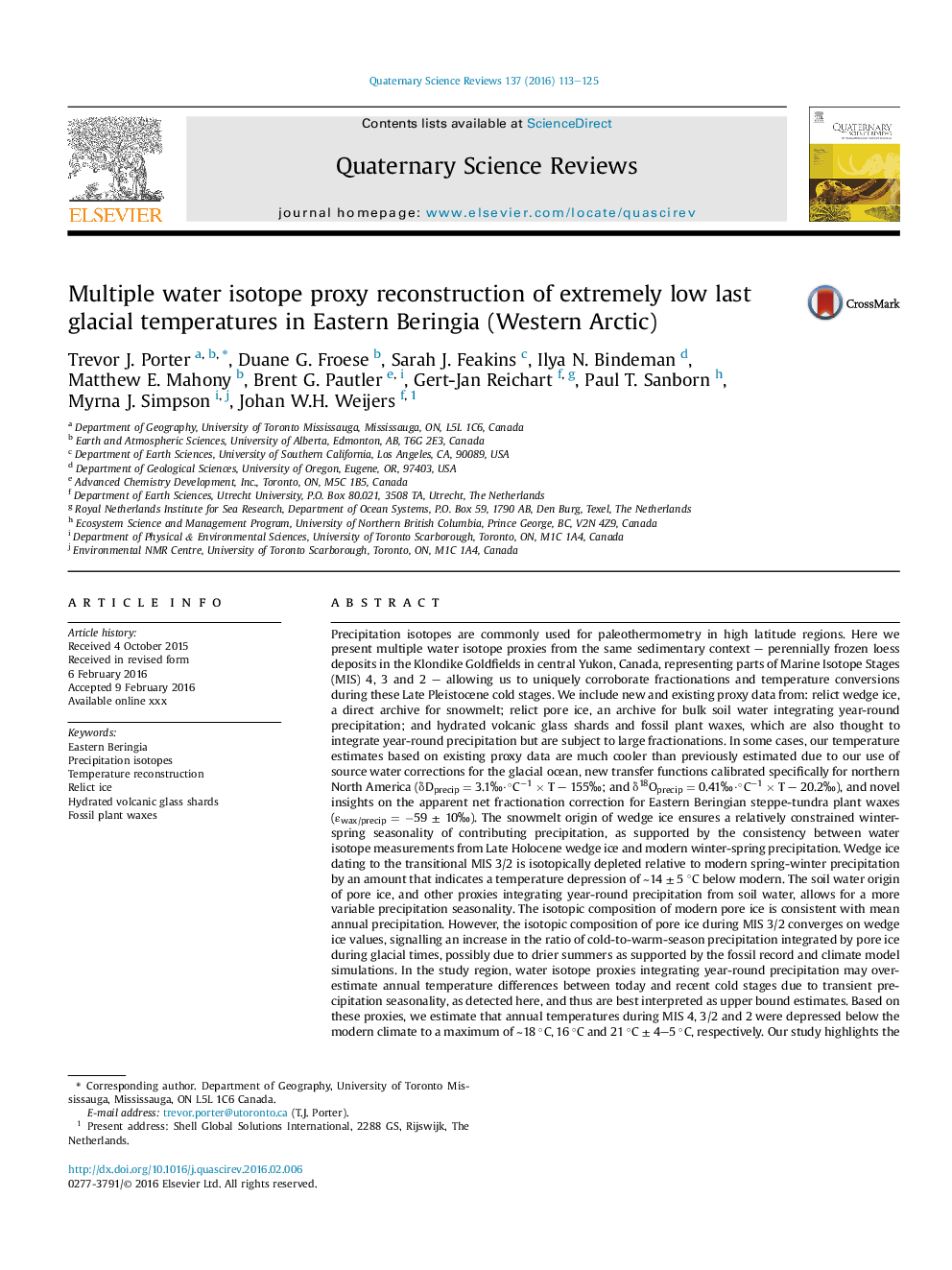| کد مقاله | کد نشریه | سال انتشار | مقاله انگلیسی | نسخه تمام متن |
|---|---|---|---|---|
| 6446512 | 1640798 | 2016 | 13 صفحه PDF | دانلود رایگان |
عنوان انگلیسی مقاله ISI
Multiple water isotope proxy reconstruction of extremely low last glacial temperatures in Eastern Beringia (Western Arctic)
ترجمه فارسی عنوان
بازسازی پروکسی ایزوتوپ چند ایزوتوپ بسیار کم دمای پایین یخبندان در شرق برینگیا (قطب شمال غرب)
دانلود مقاله + سفارش ترجمه
دانلود مقاله ISI انگلیسی
رایگان برای ایرانیان
کلمات کلیدی
برینگیا شرقی، ایزوتوپهای بارش، بازسازی دما، یخ ریختن قطعات شیشه ای آتشفشانی هیدراته شده، فسفر فسفات
موضوعات مرتبط
مهندسی و علوم پایه
علوم زمین و سیارات
زمین شناسی
چکیده انگلیسی
Precipitation isotopes are commonly used for paleothermometry in high latitude regions. Here we present multiple water isotope proxies from the same sedimentary context - perennially frozen loess deposits in the Klondike Goldfields in central Yukon, Canada, representing parts of Marine Isotope Stages (MIS) 4, 3 and 2 - allowing us to uniquely corroborate fractionations and temperature conversions during these Late Pleistocene cold stages. We include new and existing proxy data from: relict wedge ice, a direct archive for snowmelt; relict pore ice, an archive for bulk soil water integrating year-round precipitation; and hydrated volcanic glass shards and fossil plant waxes, which are also thought to integrate year-round precipitation but are subject to large fractionations. In some cases, our temperature estimates based on existing proxy data are much cooler than previously estimated due to our use of source water corrections for the glacial ocean, new transfer functions calibrated specifically for northern North America (δDprecip = 3.1â°Â·Â°Câ1 Ã T - 155â°; and δ18Oprecip = 0.41â°Â·Â°Câ1 Ã T - 20.2â°), and novel insights on the apparent net fractionation correction for Eastern Beringian steppe-tundra plant waxes (εwax/precip = â59 ± 10â°). The snowmelt origin of wedge ice ensures a relatively constrained winter-spring seasonality of contributing precipitation, as supported by the consistency between water isotope measurements from Late Holocene wedge ice and modern winter-spring precipitation. Wedge ice dating to the transitional MIS 3/2 is isotopically depleted relative to modern spring-winter precipitation by an amount that indicates a temperature depression of â¼14 ± 5 °C below modern. The soil water origin of pore ice, and other proxies integrating year-round precipitation from soil water, allows for a more variable precipitation seasonality. The isotopic composition of modern pore ice is consistent with mean annual precipitation. However, the isotopic composition of pore ice during MIS 3/2 converges on wedge ice values, signalling an increase in the ratio of cold-to-warm-season precipitation integrated by pore ice during glacial times, possibly due to drier summers as supported by the fossil record and climate model simulations. In the study region, water isotope proxies integrating year-round precipitation may overestimate annual temperature differences between today and recent cold stages due to transient precipitation seasonality, as detected here, and thus are best interpreted as upper bound estimates. Based on these proxies, we estimate that annual temperatures during MIS 4, 3/2 and 2 were depressed below the modern climate to a maximum of â¼18 °C, 16 °C and 21 °C ± 4-5 °C, respectively. Our study highlights the value of multiple water isotope proxies towards understanding changes in precipitation seasonality and developing robust reconstructions of past climate, and may be particularly important for studies of the major climate transformations over glacial-interglacial timescales.
ناشر
Database: Elsevier - ScienceDirect (ساینس دایرکت)
Journal: Quaternary Science Reviews - Volume 137, 1 April 2016, Pages 113-125
Journal: Quaternary Science Reviews - Volume 137, 1 April 2016, Pages 113-125
نویسندگان
Trevor J. Porter, Duane G. Froese, Sarah J. Feakins, Ilya N. Bindeman, Matthew E. Mahony, Brent G. Pautler, Gert-Jan Reichart, Paul T. Sanborn, Myrna J. Simpson, Johan W.H. Weijers,
